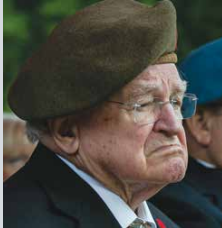
Anton “Tony” Olaf Pearson was born on 8 March 1925 in Melville, Saskatchewan. He enlisted in the Canadian Armed Forces on 15 October 1943, and first joined the Royal Canadian Armoured Corps. He said he decided to volunteer before he was conscripted. “I chose volunteering.”
Pearson was reassigned to the South Saskatchewan Regiment in September 1944, arriving with a small group of reinforcements to bring the regiment up to strength after suffering numerous battle casualties. During the Second World War, Pearson served in Canada, Belgium, Holland, Germany and the United Kingdom. Landing in Europe after D Day in Ostend, Belgium, the South Saskatchewan Regiment saw action in the Battle of the Scheldt, an Allied offensive led by the First Canadian Army which cleared German forces from land surrounding the Scheldt Estuary. This allowed Allied shipping to reach Antwerp’s port and ensure their armies liberating Western Europe were well supplied. “There was so much water, the British had blown the dykes, so the sea came in”
Pearson remembers arriving with his unit to cross the Scheldt, and the soldiers and their equipment having to make the crossing by small collapsible canvas boats, as the bridges spanning the river had been destroyed either by Allied bombing or the enemy retreating across the river. After crossing, they pushed along, capturing their targets and advancing into German held territory. Following the first attempt by the Allied forces to liberate the Netherlands, Operation Market Garden, Pearson’s unit saw action in the Netherlands. The land they moved through on their advance across the low countries was a water logged and muddy landscape. “There was so much water, the British had blown the dykes, so the sea came in.”
“Well, we can finally go home” Pearson and the South Saskatchewan Regiment were in Oldenburg, Germany when they received news that Germany had officially surrendered. Pearson says that all he can remember thinking is: “Well, we can finally go home.” However, he would not return to Canada immediately. Pearson remained in England for over a year, serving at #1 Repatriation Depot, in Surrey, England, helping organize the transportation of the Canadian troops serving in Europe. He finally returned to Canada in time for Christmas of 1946.
Serving in the CAF remained his full time occupation after the war, when he transferred to the Royal Canadian Air Force. He spent three years deployed to Whitehorse, Yukon, another five years in Flin Flon, Manitoba, and several other postings.
Pearson retired as a Chief Warrant Officer after more than 36 years of military service. For his service he was awarded the 1939 1945 Star, the France and Germany Star, the Victory Medal, the Canadian Centennial Medal, the Queen Elizabeth II Silver Jubilee Medal and the Canadian Forces Decoration. Pearson has travelled to the Netherlands every five years since 1980, to attend events marking the country’s liberation. He says that making friends during the liberation of Europe was difficult at the time, he has since become close with some locals and spent time exploring the region as he has returned to where he once fought.
Following the Second World War he married his wife, who has since passed away, and together they had three sons. He currently lives in Nanaimo, British Columbia where he remains an active member of the Air Force Association, the Royal Canadian Legion, Armed Forces Pensioners and the United Services Institute of Nanaimo & North Islands.
In honour of the 75th anniversary of the Battle of the Scheldt, Chief Warrant Officer (Retired) Anton “Tony” Olaf Pearson is one of our Faces of Freedom. He recently attended events in Belgium commemorating the Battle of the Scheldt.

Leave a Reply